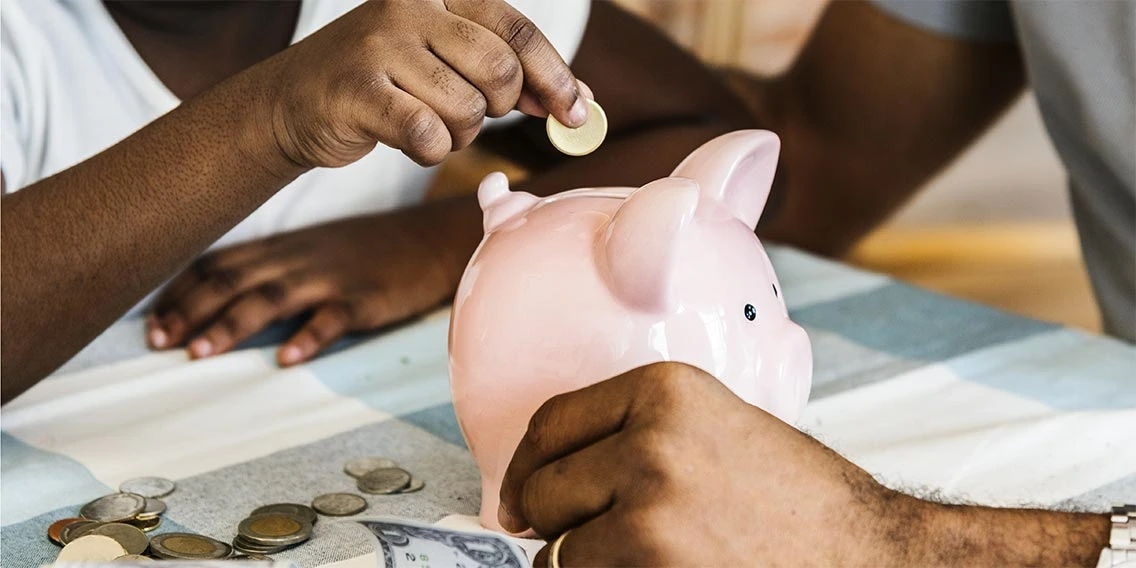YOUTH FINANCE
What Is Money? A Read-Along Guide for Kids and Parents
EXPECTED READ TIME:4 minutes
Age group: 6-12 years old
Money is important to our world. It’s how we pay for needs or wants. But what is it, and where did it come from? Let’s find out!
What Is Money?
Money is anything that people in a society can exchange for goods and services. Although things like stones and shells have been used as money in the past, today we use two types of money, also known as “cash”:
Bills: money printed on a blend of paper and cotton
Coins: small pieces of stamped metal
Did You Know?
China invented the first paper money around 900 CE. Merchants trading long distances would carry lots of metal coins to trade, but coins can get heavy! They invented paper money to make it easy to carry money long distances.
Money is anything that people in a society can exchange for goods and services.
The History of Money
Long, long ago people didn’t have money. Instead, they traded for things they wanted. (You might have done something similar if you’ve ever traded your lunch with a classmate at school.)
If you wanted a goat, then you might give your neighbor some chickens in exchange. You and your neighbor would have to decide how many chickens one goat was worth. This system is called the barter system. (Barter is an old word that means to trade.)
Barter is an old word that means to trade.
Eventually, people began using beads, shells, or pieces of metal to trade for things they wanted. As villages became cities and people formed governments, they found it was helpful if everyone used the same thing to buy goods and pay workers. Governments began creating metal coins with stamped designs that we now call money.
Did You Know?
The first country we know of that used metal money was the kingdom of Lydia, located in present-day Turkey. They began making coins of silver and gold in the 600s BCE!
Paper money in the U.S. has a number on the front telling you how much it is worth.
Identifying Types of Money
Paper money in the U.S. has a number on the front telling you how much it is worth. That number is called a denomination. Paper money comes in denominations of $1, $5, $10, $20, $50, $100, and $500.
Coins have their denomination stamped on them. The chart below describes the four most popular coins used in the U.S.
|
Coin |
Value |
Description |
|---|---|---|
|
Quarter |
25 cents |
Silver colored The biggest coin Features President George Washington Has an eagle or U.S. history-themed image on the back |
|
Dime |
10 cents |
Silver colored The smallest coin Features President Franklin Roosevelt Has a torch on the back |
|
Nickel |
5 cents |
Silver colored Features President Thomas Jefferson Has a picture of a mansion on the back |
|
Penny |
1 cent |
Copper Features President Abraham Lincoln Has a shield on the back |
Did You Know?
The design on coins often gets updated. For example, pennies used to have the Lincoln Memorial on the back until 2009. Old coins still get used even when a design changes, so you might find coins that don’t match the current designs listed above.
Where Do We Store Money?
People can store their money anywhere they want, but most people store money in banks or credit unions. These are special institutions that can keep your money safe and help you use it when you need it. They also provide tools to let you use your money digitally instead of always carrying it with you.
Money at banks or credit unions is stored in an account. There are two main types of accounts:
Checking Accounts: This is where you store money you want to spend on food, a place to live, and other things you need to buy.
Savings Accounts: This is where you store money you want to save.
You can learn more about these types of accounts in our article What’s the Difference Between Checking and Savings Accounts?
Today we use computers to keep track of our money instead of carrying it in our pockets or bags.
Why Don’t My Parents Pay With Cash?
If you’ve ever gone shopping with an adult, you might have seen them pay with something other than paper money or coins. That’s because today we use computers to keep track of our money instead of carrying it in our pockets or bags.
Debit Cards and Credit Cards
A debit card is a small, plastic rectangle with a black stripe or small microchip. The stripe or chip stores information about your checking account. When you use it at a store, money get subtracted from your checking account.
A credit card looks like a debit card, but it lets you borrow money from a credit card company to pay for something. You then pay the money back at a later date. Since credit is a service, the company charges you extra money in addition to your purchase just to use the card.
A digital wallet is a phone app that works like a debit card.
Digital Wallets
A digital wallet is a phone app that works like a debit card. It contains your checking account information, but you scan it instead of swiping or tapping it.
Checks
Checks are paper rectangles that have your checking account information printed on them. To pay with a check, you write down:
- Who you want to pay
- How much you want to pay them
- Your signature
Checks used to be very popular but have mostly been replaced by cards and digital wallets.
Checks used to be very popular but have mostly been replaced by cards and digital wallets.
The Takeaway
Even though there are lots of different types of money and different ways to store and use it, money is a universal tool that humans have been using for a very long time.
14 Ways to Teach Kids About Money
Discover our guide to teaching kids about money, broken down by major age groups.




